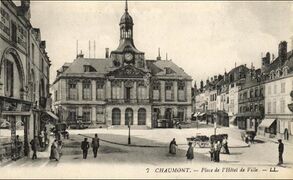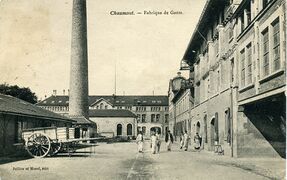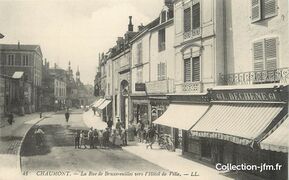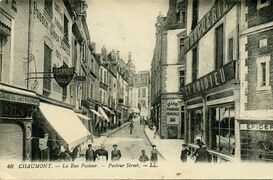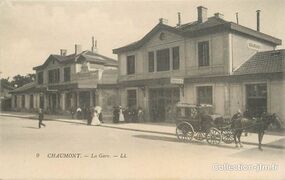Chaumont: Difference between revisions
(Introduction -> International Phonetic Alphabet) |
|||
| (4 intermediate revisions by the same user not shown) | |||
| Line 6: | Line 6: | ||
| settlement_type = City | | settlement_type = City | ||
| official_name = City of Chaumont | | official_name = City of Chaumont | ||
| image_skyline = | | image_skyline = Eglise Saint-Jean-Baptiste - Ensemble sud-ouest - Chaumont - Médiathèque de l'architecture et du patrimoine - APMH00000786.jpg | ||
| imagesize = 290px | | imagesize = 290px | ||
| image_flag = Blason de la ville de Chaumont (52).svg | | image_flag = Blason de la ville de Chaumont (52).svg | ||
| Line 29: | Line 29: | ||
| population_as_of = 2021 | | population_as_of = 2021 | ||
| population_total = 69 552 | | population_total = 69 552 | ||
| population_rank = [[ | | population_rank = [[List_of_largest_cities_in_Voisey|9th in Voisey]] | ||
| population_urban = 69 552 | | population_urban = 69 552 | ||
| population_metro = 102 459 ([[List of Voisey's metropolitan statistical areas|?th]]) | | population_metro = 102 459 ([[List of Voisey's metropolitan statistical areas|?th]]) | ||
| Line 43: | Line 43: | ||
Chaumont was founded in 8500 BC at the top of the Buxereuil hill. The city was populated with about 50 inhabitants and quickly became important on the North-South road of the voiseyian territory. | Chaumont was founded in 8500 BC at the top of the Buxereuil hill. The city was populated with about 50 inhabitants and quickly became important on the North-South road of the voiseyian territory. | ||
The seigneury quickly made a name for itself, invading the neighbouring seigneuries of Bologne and Andelot in the 350s and 400s. Around 550, the Chaumont seigneurie invaded those of Châteauvillain, Colombey and Mormant. The latter lordship, which was not very powerful and was controlled by a religious order, was also coveted by the powerful lordship of [[Langres]], further south. This marked the beginning of tensions between Chaumont and Langres, which were to remain rooted for several hundred years. Around 588, the two lordships went to war over the seigneury of Nogent. As the two lordships were of equal strength, the war ended in a white peace in 594. In 600, to make up for its strategic defeat at the Langrois, Chaumont invaded the seigneury of Froncles, a small seigneury to the north. Chaumont thus attracted a second enemy: the seigneury of Joinville (more commonly known as Vallage). In 652, the Langrois was defeated by the lordship of [[Voisey]], a power from some fifty kilometres to the south. The Lord of Chaumont, Baudoin VII de Chamarande, saw this as an opportunity to gain a powerful ally in his fight against the Vallage and the Châtillonais (another enemy lordship from the west). <br> | |||
The | |||
In | In 679, Chaumont lost two battles that signed its death certificate at Mussey-sur-Marne, against the armies of Vallage, and at Gevrolles, against the armies of Chatillonais. Considerably weakened and weakly administered by Lord Hugues II de Choignes, the seigneury of Chaumont was forced to cede its western part to the seigneury of Châtillonais, and its northern part to Vallage. In February 680, revolts against the power took place throughout the seigneury. To quell the revolts, Hugues II organised raids on the villages, which were burnt down and the inhabitants imprisoned, exiled or killed. In April 680, Hugues II was assassinated after his palace was taken by the inhabitants of Chaumont, who were in revolt. The lord who succeeded him, Paulin I, was forced to abdicate the following month. In July 680, Voisey declared war on Chaumont. It is thought that this was a request from the rebels of the former lordship of Nogent, who wished to join forces with Voisey. In any case, in September 680, the seigneury of Chaumont surrendered and was incorporated into Voisey. | ||
Chaumont became the capital of Voisey in 1010. From 1010, Chaumont became the seat of the country's main institutions. The lords (with a few exceptions) resided there and administered the seigneury, which had grown considerably. The town was also very dynamic, with crafts linked to canvas and textiles in general. | |||
In 1145, the Cathedral of St. Simonne de Chaumont was built. It was the first in the world. <br> | |||
In 1323, during the Great Storm, the river Marne flooded the plains surrounding the town, as well as the small villages. Most of the inhabitants of these villages sought refuge in the capital, which struggled to accommodate them. The streets were overrun with tents and shelters, food quickly became scarce and tuberculosis ravaged the population. It is estimated that tens of thousands of people died in Chaumont during this episode. | |||
During the industrial revolution, the population of Chaumont exploded. The city became very dynamic and many industries were established such as glove factories, steel mills, paper mills and leather factories. | During the industrial revolution, the population of Chaumont exploded. The city became very dynamic and many industries were established such as glove factories, steel mills, paper mills and leather factories. | ||
During the [[Great War ( | During the [[Great War (Primeria)|Great War]], the city was only later targeted by bombing. Indeed, the generals of the Matamoros agreed to keep the city intact, to discredit the neighboring army, and show that no bombardment is necessary to capture the city. Note that the city was never reached by the troops of the Matamoros, who were stopped in Langres, about thirty kilometers from Chaumont. The city will suffer only a very light bombardment, which will not cause any casualties. However, the city will welcome several thousand refugees from [[Carélie]], [[Brenne]] and the rest of the country, having fled the advance of enemy troops. According to a count of the municipality at the time, there were about 2500 brennians, 5000 carelians and more than 20 000 voiseyians in Chaumont between 1973 and 1980.<br> | ||
Today, Chaumont is, like many other capitals, not the largest city in the country even though many activities are concentrated there. The third best university in the country is located here. | Today, Chaumont is, like many other capitals, not the largest city in the country even though many activities are concentrated there. The third best university in the country is located here. | ||
Many monuments of the city such as the | Many monuments of the city such as the Cathedral Sainte-Simonne, the ramparts or the old center are classified as monuments and historical places. | ||
| Line 143: | Line 145: | ||
* Strasbourg, [[Brenne]] | * Strasbourg, [[Brenne]] | ||
* Caen, [[Bessin]] | * Caen, [[Bessin]] | ||
* Lille, [[Artoisia|Artoisie]] | * Lille, [[Artoisia|Artoisie]] | ||
* Noiseau, [[Voisey]] | * Noiseau, [[Voisey]] | ||
* Rennes, Porhoët | * Rennes, Porhoët | ||
* Châlans, [[Carélie]] | |||
* Pritinia, [[Blaciasie]] | |||
* Den Haver, Caspburg | |||
* Poitiers, [[Touloisie]] | |||
* Budapest, Hongroisie | |||
==Transportation== | ==Transportation== | ||
<gallery> | |||
File:Metromapmaker(3).png|centre|Map of Chaumont's metro system. Other lines (orange, purple and red) aren't metro, orange and purple they are Express Regional Trains and red is the agglo-system bus. | |||
</gallery> | |||
Chaumont's subway system is the oldest in the world, dating back to 1890. At the beginning, only line 1 (green) existed. In 1920, the [[Dijon]]-[[Verdun]] Regional Express Train (TER) line (orange) was laid out and passed near Chaumont. In 1930, the line was extended and passed through Chaumont. In 1925, the red line is traced and passes by Chaumont. It is a Trans-Metro, which allows to move in the metropolis of Chaumont. Chaumont is only a stop because this line starts from the northern end of the metropolis, Joinville-en-Vallage, and goes down to the south, Langres, even though these two cities are their own districts. Finally, in 1932, the purple line is traced and connects this time the eastern (Montigny-le-Roi) and western ([[Chateauvillain]]) ends. | |||
The National 67 passes near Chaumont and connects the South of the Haute-Marne to Saint-Dizier, the North of the department. | |||
Chaumont has also its bus network (C mon bus) which means "It's my bus" in an original way. The international airport of [[Chaumont-La Vendue]] is located west of the city and connects all the other big cities of the country as well as other international destinations. | |||
==Chaumont in pictures== | |||
In Voisey, postcard photos are always black and white. The technology of color photos dates from the years 1990-2000 and is therefore very recent. The images below are very recent (2021). | |||
Chaumont | <gallery mode=packed> | ||
File:Place de l'HDV - Chaumont (antan).jpg|The townhall and the townhall place | |||
File:Ganterie Tréfousse - CHaumont (antan).jpg| The famous Tréfousse glove factory, an ancestral glove factory | |||
File:La Rue de Buxereuilles - Chaumont (antan).jpg| Buxereuilles Street, heading to the townhall | |||
File:Rue Pasteur - Chaumont (antan).jpg|Pasteur Street, one of the liveliest streets in Chaumont | |||
File:La Gare - CHaumont (antan).jpg| The railway station | |||
</gallery> | |||
Latest revision as of 19:46, 26 September 2024
Chaumont (/ʃo.mɔ̃/), also called Chaumont-en-Bassigny (/ʃo.mɔ̃.ɑ̃.ba.si.ɲi/), is the capital of Voisey. Chaumont is located in the Haute-Marne department of which it is the prefecture. The city had 69 552 inhabitants in 2021, which does not make it the largest city in the country. Its inhabitants are called Chaumontais and Chaumontaise.
Chaumont | |
|---|---|
City | |
| City of Chaumont | |
 | |
| Etymology: French: Chaumont | |
| Nickname(s): First City, The city on top, The little big one | |
| Coordinates: 48° 06′ 42″ nord, 5° 08′ 20″ est | |
| Country | Voisey |
| State | Champagne-Ardenne |
| Department | Haute-Marne |
| Founded | 8500 BC |
| Government | |
| • Mayor | Jean Dehaye (UGC) |
| Area | |
| • City | 5,526 km2 (2,134 sq mi) |
| • Land | 5,526 km2 (2,134 sq mi) |
| • Water | 10.67 km2 (4.12 sq mi) |
| Elevation | 164 m (538 ft) |
| Population (2021) | |
| • City | 69 552 |
| • Rank | 9th in Voisey |
| • Urban | 69 552 |
| • Metro | 102 459 (?th) |
| Demonym(s) | Chaumontais, Chaumontaise |
| Time zone | UTC+1 |
| • Summer (DST) | +2 |
History
Chaumont was founded in 8500 BC at the top of the Buxereuil hill. The city was populated with about 50 inhabitants and quickly became important on the North-South road of the voiseyian territory.
The seigneury quickly made a name for itself, invading the neighbouring seigneuries of Bologne and Andelot in the 350s and 400s. Around 550, the Chaumont seigneurie invaded those of Châteauvillain, Colombey and Mormant. The latter lordship, which was not very powerful and was controlled by a religious order, was also coveted by the powerful lordship of Langres, further south. This marked the beginning of tensions between Chaumont and Langres, which were to remain rooted for several hundred years. Around 588, the two lordships went to war over the seigneury of Nogent. As the two lordships were of equal strength, the war ended in a white peace in 594. In 600, to make up for its strategic defeat at the Langrois, Chaumont invaded the seigneury of Froncles, a small seigneury to the north. Chaumont thus attracted a second enemy: the seigneury of Joinville (more commonly known as Vallage). In 652, the Langrois was defeated by the lordship of Voisey, a power from some fifty kilometres to the south. The Lord of Chaumont, Baudoin VII de Chamarande, saw this as an opportunity to gain a powerful ally in his fight against the Vallage and the Châtillonais (another enemy lordship from the west).
In 679, Chaumont lost two battles that signed its death certificate at Mussey-sur-Marne, against the armies of Vallage, and at Gevrolles, against the armies of Chatillonais. Considerably weakened and weakly administered by Lord Hugues II de Choignes, the seigneury of Chaumont was forced to cede its western part to the seigneury of Châtillonais, and its northern part to Vallage. In February 680, revolts against the power took place throughout the seigneury. To quell the revolts, Hugues II organised raids on the villages, which were burnt down and the inhabitants imprisoned, exiled or killed. In April 680, Hugues II was assassinated after his palace was taken by the inhabitants of Chaumont, who were in revolt. The lord who succeeded him, Paulin I, was forced to abdicate the following month. In July 680, Voisey declared war on Chaumont. It is thought that this was a request from the rebels of the former lordship of Nogent, who wished to join forces with Voisey. In any case, in September 680, the seigneury of Chaumont surrendered and was incorporated into Voisey.
Chaumont became the capital of Voisey in 1010. From 1010, Chaumont became the seat of the country's main institutions. The lords (with a few exceptions) resided there and administered the seigneury, which had grown considerably. The town was also very dynamic, with crafts linked to canvas and textiles in general.
In 1145, the Cathedral of St. Simonne de Chaumont was built. It was the first in the world.
In 1323, during the Great Storm, the river Marne flooded the plains surrounding the town, as well as the small villages. Most of the inhabitants of these villages sought refuge in the capital, which struggled to accommodate them. The streets were overrun with tents and shelters, food quickly became scarce and tuberculosis ravaged the population. It is estimated that tens of thousands of people died in Chaumont during this episode.
During the industrial revolution, the population of Chaumont exploded. The city became very dynamic and many industries were established such as glove factories, steel mills, paper mills and leather factories.
During the Great War, the city was only later targeted by bombing. Indeed, the generals of the Matamoros agreed to keep the city intact, to discredit the neighboring army, and show that no bombardment is necessary to capture the city. Note that the city was never reached by the troops of the Matamoros, who were stopped in Langres, about thirty kilometers from Chaumont. The city will suffer only a very light bombardment, which will not cause any casualties. However, the city will welcome several thousand refugees from Carélie, Brenne and the rest of the country, having fled the advance of enemy troops. According to a count of the municipality at the time, there were about 2500 brennians, 5000 carelians and more than 20 000 voiseyians in Chaumont between 1973 and 1980.
Today, Chaumont is, like many other capitals, not the largest city in the country even though many activities are concentrated there. The third best university in the country is located here. Many monuments of the city such as the Cathedral Sainte-Simonne, the ramparts or the old center are classified as monuments and historical places.
Demography
Chaumont has a population of 69,552 in 2021. It is the 9th largest city in the country. Its demography has evolved a lot and has known many falls. The graph below shows the evolution of the population between 1800 and 2021.
| Demographic Evolution of Chaumont (1800-2021) | |||||||||||||||||||||||||||||||||||||||||||||||||||||||||||||||||||||||||||||||||||||||||||||||||||||||||||||||||||||||||||||||||||||||||||||||||||||||||||||
|---|---|---|---|---|---|---|---|---|---|---|---|---|---|---|---|---|---|---|---|---|---|---|---|---|---|---|---|---|---|---|---|---|---|---|---|---|---|---|---|---|---|---|---|---|---|---|---|---|---|---|---|---|---|---|---|---|---|---|---|---|---|---|---|---|---|---|---|---|---|---|---|---|---|---|---|---|---|---|---|---|---|---|---|---|---|---|---|---|---|---|---|---|---|---|---|---|---|---|---|---|---|---|---|---|---|---|---|---|---|---|---|---|---|---|---|---|---|---|---|---|---|---|---|---|---|---|---|---|---|---|---|---|---|---|---|---|---|---|---|---|---|---|---|---|---|---|---|---|---|---|---|---|---|---|---|---|---|
|
| ||||||||||||||||||||||||||||||||||||||||||||||||||||||||||||||||||||||||||||||||||||||||||||||||||||||||||||||||||||||||||||||||||||||||||||||||||||||||||||
| Source: INSED (Institut National de Statitistiques de d'Etudes Démographiques) en: (National Institute of Statistics and Demographic Studies) | |||||||||||||||||||||||||||||||||||||||||||||||||||||||||||||||||||||||||||||||||||||||||||||||||||||||||||||||||||||||||||||||||||||||||||||||||||||||||||||
Geography
Chaumont is located in the center-east of Voisey, in the region of Champagne-Ardenne and in the center of the department of Haute-Marne of which it is the prefecture. The center of Chaumont is located on the top of the hill of Buxereuil at 416m. The Suize and the Marne rivers flow below the hill.
Economy
The economy of Chaumont is mainly based on small businesses and industry. Chaumont is a very lively town and is appreciated for its many restaurants serving quality dishes with local products for very low prices. The hotel business has also been very successful in Chaumont. The industrial sector of the end of the 19th century has always persisted in Chaumont and in 1956 the Avenira zone was inaugurated. This zone is in fact an important grouping of factories and logistics companies. It groups together several activities such as the molding of nuclear parts, rocket and airplane parts, sawmills, steelworks, recycling... Chaumont is also a tourist city since it receives 10 million tourists per year in 2020. In order to help the farmers in the area, Chaumont is also part of the Pacte d'Entraide Urbano Rural (PEUR). The farmers' crops are optimized and the city improves the quality of its food.
Twinning
Chaumont is twinned with the following cities:
- Strasbourg, Brenne
- Caen, Bessin
- Lille, Artoisie
- Noiseau, Voisey
- Rennes, Porhoët
- Châlans, Carélie
- Pritinia, Blaciasie
- Den Haver, Caspburg
- Poitiers, Touloisie
- Budapest, Hongroisie
Transportation
Chaumont's subway system is the oldest in the world, dating back to 1890. At the beginning, only line 1 (green) existed. In 1920, the Dijon-Verdun Regional Express Train (TER) line (orange) was laid out and passed near Chaumont. In 1930, the line was extended and passed through Chaumont. In 1925, the red line is traced and passes by Chaumont. It is a Trans-Metro, which allows to move in the metropolis of Chaumont. Chaumont is only a stop because this line starts from the northern end of the metropolis, Joinville-en-Vallage, and goes down to the south, Langres, even though these two cities are their own districts. Finally, in 1932, the purple line is traced and connects this time the eastern (Montigny-le-Roi) and western (Chateauvillain) ends. The National 67 passes near Chaumont and connects the South of the Haute-Marne to Saint-Dizier, the North of the department. Chaumont has also its bus network (C mon bus) which means "It's my bus" in an original way. The international airport of Chaumont-La Vendue is located west of the city and connects all the other big cities of the country as well as other international destinations.
Chaumont in pictures
In Voisey, postcard photos are always black and white. The technology of color photos dates from the years 1990-2000 and is therefore very recent. The images below are very recent (2021).

